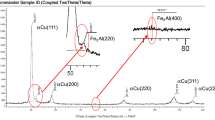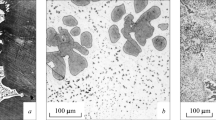Abstract
The purpose of this study was to increase the fatigue strength of single-phase CuAl8Fe3 aluminum bronze via surface cold work. CuAl8Fe3 bronze possesses a unique combination of mechanical and chemical properties: good strength, excellent electro-chemical and general corrosion resistance, high ductility and wear resistance. However, due to its low aluminum content (below 8.5%), this bronze cannot be heat treated. Thus, the fatigue strength increase was achieved via diamond burnishing (DB). The quantification of the fatigue behavior of this bronze was achieved through rotating bending fatigue tests. The assessment of the fatigue strength improvement (FSI) due to DB was made on the basis of the S–N curve obtained from fatigue tests of samples processed by fine turning. FSI due to single-pass DB fluctuates between 12 and 13%, with the maximum value achieved at the beginning of the megacycle fatigue field. The increase in the number of passes leads to a significant increase in FSI of between 16.6 and 24.4%. Since a direct correlation exists between the surface integrity (SI) and fatigue behavior, the positive effect of DB on FSI is explained by the improved SI—appropriate surface texture, increased micro-hardness, useful compressive residual stresses and grain refinement in the microstructure of the surface and sub-surface layers.













Similar content being viewed by others
Abbreviations
- \(a_{{\text{c}}}\) :
-
Depth of cutting
- \(A_{5}\) :
-
Elongation
- \(d\) :
-
Diameter
- \(E\) :
-
Young’s modulus
- \(f\) :
-
Feed rate
- \(F_{{\text{b}}}\) :
-
Burnishing force
- \({\text{HV}}\) :
-
Vickers micro-hardness
- \(n\) :
-
Number of passes
- \(N_{i}\) :
-
Number of cycles to failure
- \(r\) :
-
Diamond insert radius
- \(R\) :
-
Asymmetry coefficient
- \(R_{0,2}\) :
-
Yield limit
- \(R_{{\text{a}}}\) :
-
Arithmetic mean deviation
- \(R_{m}\) :
-
Ultimate stress
- \(s_{i}\) :
-
X-ray elastic constant
- \(S - N\) :
-
Stress–Number of cycles
- \(S_{{\text{a}}}\) :
-
Arithmetic mean deviation
- \(S_{{{\text{ku}}}}\) :
-
Kurtosis
- \(S_{{\text{p}}}\) :
-
Maximum peak height
- \(S_{q}\) :
-
Root-mean-square deviation
- \(S_{{\text{t}}}\) :
-
Total height
- \(S_{z}\) :
-
Ten-point height
- \(v\) :
-
Burnishing velocity
- \(v_{{\text{c}}}\) :
-
Cutting velocity
- \(\sigma_{i}^{j}\) :
-
Residual stress
- DB:
-
Diamond burnishing
- FSI:
-
Fatigue strength improvement
- FSP:
-
Friction stir processing
- HCF:
-
High-cycle fatigue
- LCF:
-
Low-cycle fatigue
- SEM:
-
Scanning electron microscopy
- SE:
-
Surface engineering
- SI:
-
Surface integrity
References
Maximov JT, Duncheva GV, Anchev AP, Ichkova MD (2019) Slide burnishing—review and prospects. Int J Adv Manuf Technol 104:785–801
Mishra RS, Kumar N, De PS (2014) Friction Stir welding and processing. Springer International Publishing, Switzerland, ISBN 978-3-319-07043-8 (eBook)
Luo H, Liu J, Wang L, Zhong Q (2006) The effect of burnishing parameters on burnishing force and surface microhardness. Int J Adv Manuf Technol 28(7–8):707–713
Luo H, Liu J, Zhong Q (2005) Investigation of the burnishing process with PCD tool on non-ferrous metals. Int J Adv Manuf Technol 25(5–6):454–459
Shiou FJ, Banh QN (2016) Development of an innovative small ball-burnishing tool embedded with a load cell. Int J Adv Manuf Technol 87(1–4):31–41
Eranno A, Doudard C, Moyne S, Calloch S, Millot T, Bellevre D (2015) Validation of a high cycle fatigue model via calculation/test comparisons at structural scale: application to copper alloy sand-cast ship propellers. Int J Fatigue 74:38–45
Wang S, Shen W, Guo J, Yuan T, Qiu Y, Tao Q (2020) Engineering prediction of fatigue strength for copper alloy netting structure by experimental method. Aquac Eng 90:102087
Altenberger I, Kuhn HA, Müller HR (2015) Material properties of high-strength beryllium-free copper alloys. Int J Mater Prod Technol 50(2):124–146
Liu R, Tian Y, Zhang Z, An X, Zhang P, Zhang Z (2016) Exceptional high fatigue strength in Cu-15at.%Al alloy with moderate grain size. Sci Rep 6:27433. https://doi.org/10.1038/srep27433
Wang C, Jiang C, Zhao Y, Chen M, Ji V (2017) Surface mechanical property and residual stress of peened nickel–aluminum bronze determined by in-situ X-ray diffraction. Appl Surf Sci 420:28–33
Gao Y, Yang W, Huang Z, Lu Z (2021) Effects of residual stress and surface roughness on the fatigue life of nickel-aluminium bronze alloy under laser shock peening. Eng Fract Mech 244:107524
Mahoney M, Fuller C, Bingel W, Calabrese M (2007) Friction stir processing of cast NiAl bronze. Mater Sci Forum 539–543:3721–3726
Lv Y, Nie B, Wang L, Cui H, Li L, Wang R, Lyu F (2020) Optimal microstructures on fatigue properties of friction stir processed NiAl bronze alloy and its resistant fatigue crack growth mechanism. Mater Sci Eng A 771:138577
Prevey PS, Douglas JH, Jayaraman N (2007) Controlled plasticity burnishing to improve the performance of friction stir processed Ni–Al bronze. Mater Sci Forum 539:3807–3813
Xu X, LvY HuM, Xiong D, Zhang L, Wang L, Lu W (2016) Influence of second phases on fatigue crack growth behaviour of nickel aluminium bronze. Int J Fatigue 82(3):579–587
Mombeini D, Atrian A (2018) Investigation of deep cold rolling effects on the bending fatigue of brass C38500. Latin Am J Sol Struct 15(4):e36
Fouad Y, Mhaede M, Wagner L (2010) Effect of mechanical surface treatments on fatigue performance of extruded ZK60 alloy. Fatigue Fract Eng Mater Struct 34:403–407
Duncheva GV, Maximov JT, Dunchev VP, Anchev AP, Atanasov TP (2021) Improvement in fatigue performance of 2024–T3 Al Alloy via single toroidal roller burnishing. J Mater Eng Perform 30:2256–2266
Maximov JT, Anchev AP, Duncheva GV, Ganev N, Selimov KF, Dunchev VP (2019) Impact of slide diamond burnishing additional parameters on fatigue behaviour of 2024–T3 Al alloy. Fatigue Fract Eng Mater Struct 42(1):363–373
ASME B46.1-2009 (2009) Surface texture (Surface Roughness, Waviness, and Lay), An American National Standard
Zhang J, Pei ZJ (2010) Characterization methods for surface integrity (Ed., J. Paulo), Surface integrity in mashining, Springer, Verlag London Limited e-ISBN 978-1-84-882-974-2
Acknowledgements
This work was supported by: (1) the European Regional Development Fund within the OP, Science and Education for Smart Growth 2014-2020,” Project CoC “Smart Mechatronics, Eco- and Energy Saving Systems and Technologies,” No. BG05M2OP001-1.002-0023; (2) the project CZ.02.1.01/0.0/0.0/16_019/0000778 “Center for advanced applied science” within the Operational Program Research, Development and Education supervised by the Ministry of Education, Youth and Sports of the Czech Republic.
Author information
Authors and Affiliations
Corresponding author
Additional information
Technical Editor: Izabel Fernanda Machado.
Publisher's Note
Springer Nature remains neutral with regard to jurisdictional claims in published maps and institutional affiliations.
Rights and permissions
About this article
Cite this article
Duncheva, G.V., Maximov, J.T., Anchev, A.P. et al. Fatigue strength improvement in CuAl8Fe3 bronze via diamond burnishing. J Braz. Soc. Mech. Sci. Eng. 43, 569 (2021). https://doi.org/10.1007/s40430-021-03296-8
Received:
Accepted:
Published:
DOI: https://doi.org/10.1007/s40430-021-03296-8




